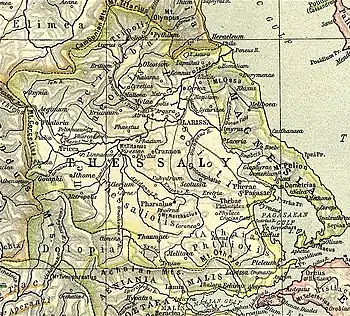38°52′51″N 22°47′20″E / 38.88083°N 22.78889°E

Alope (Ancient Greek: Ἀλόπη, romanized: Alópē) was a town of Phthiotis in Ancient Thessaly, placed by Stephanus of Byzantium between Larissa Cremaste and Echinus. There was a dispute among the ancient critics whether this town was the same as the Alope in Homer's Catalog of Ships.[1][2][3] Strabo distinguishes the town from two others of the same name, Alope in the area of Opuntian Locris and Alope in that of Ozolian Locris.[4][5] The editors of the Barrington Atlas of the Greek and Roman World tentatively locate Alope with the modern village of Fournoi in the municipality of Echinaioi.[6]
References
- ↑ Homer. Iliad. Vol. 2.682.
- ↑ Strabo. Geographica. Vol. pp. 427, 432. Page numbers refer to those of Isaac Casaubon's edition.
- ↑ Stephanus of Byzantium. Ethnica. Vol. s.v.
- ↑ Strabo. Geographica. Vol. IX.4.9, pp. 426, 427. Page numbers refer to those of Isaac Casaubon's edition.
- ↑ Johannes Toepffer: Alope 1.(in German) In: Realencyclopädie der classischen Altertumswissenschaft (RE). Vol. I,2, Stuttgart 1894, col. 1595.
- ↑ Richard Talbert, ed. (2000). Barrington Atlas of the Greek and Roman World. Princeton University Press. p. 55, and directory notes accompanying.
![]() This article incorporates text from a publication now in the public domain: Smith, William, ed. (1854–1857). "Alope". Dictionary of Greek and Roman Geography. London: John Murray.
This article incorporates text from a publication now in the public domain: Smith, William, ed. (1854–1857). "Alope". Dictionary of Greek and Roman Geography. London: John Murray.